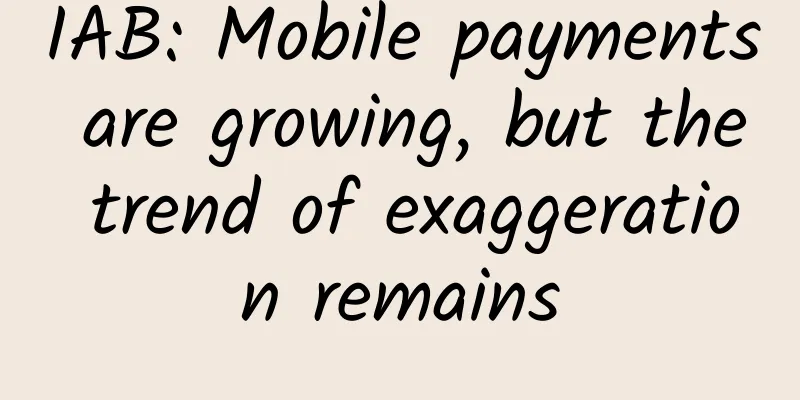IAB: Mobile payments are growing, but the trend of exaggeration remains

|
Mobile payment refers to the use of mobile electronic devices to pay for consumption in physical stores. It still takes several years for this method to become popular. Two weeks ago, IAB and InMobi jointly released a report on the coverage of the mobile payment industry and financial-related behaviors. The report covered about 1,200 American adult respondents and interviewed them in the first quarter of 2013. The report shows that mobile payment has achieved certain results in some mobile financial services, such as electronic coupons, purchase of virtual items, and bill payment using smartphones. However, there is still a long way to go (3 years or even longer) for near-field payment in physical stores. In contrast, the development speed of mobile banking, another form of mobile financial services, is faster than the expectations of financial institutions. However, mobile banking services are actually just an extension of online banking on mobile terminals. Users access online banking through tablets or smartphones to obtain information they have already obtained on traditional computers. Therefore, mobile banking services do not have core business innovations, except for mobile deposit services that have not yet been widely promoted. Do you know what mobile financial services your card issuer offers? Collecting and redeeming coupons is the most used mobile financial service among the respondents, with a usage rate of 57%. This figure is not surprising, as users have a strong demand for mobile electronic coupons. Also noteworthy is the rate of using their mobile phone to pay bills (most likely credit card bills), which reached 46%, and the rate of using their mobile phone to pay bills was also 42%. Looking at mobile payments in physical stores or offline, 34% of respondents said they have used this type of transaction. If you can see the data of mobile phone user surveys across the United States, the 34% figure should be much higher than the actual number. The author suspects that the real number should be between 10% and 15% (unless they are talking about an application like Starbucks where user loyalty is very high). Have you ever used your mobile phone to make payments? It would be valuable to know more about what “Purchase of physical goods or services” conveys , but unfortunately the survey doesn’t provide us with more information. For example, is this data using PayPal? Is it a form of acceptance similar to prepaid cards? Or is it acceptance using Square terminals? Or is it, as mentioned above, a user loyalty app? Among financial payment applications, PayPal undoubtedly occupies the top spot (PayPal is rapidly promoting its near-field payment application in terminal physical stores through cooperation with Discover Network). As can be seen from the chart, about 37% of the respondents said that they have PayPal clients installed on their mobile phones. The question raised in this survey is whether the user has "downloaded" the application rather than actively using it, so the actual usage of users is not known for the time being. Have you downloaded any of the following mobile apps to make payments or record transactions? Square is another mobile payment brand that is widely known by users. Its products account for 8% of the respondents. Here we refer to its mobile application products, not Square's terminal card swiping devices. The "Pay with Square" application supports near-field contactless payments, which requires both parties of the initial payment to have a Square account (the "Purchase physical goods or services" option is suspicious and already includes the use of Square hardware terminals). Google Wallet's loss of popularity has caused its retention rate among respondents to drop to 7%. The NFC function of Android and Windows Phone phones is very functional and universal, but it is difficult for NFC to make NFC payments widely used in North America by its own strength. If the iPhone 5S adds NFC function, this situation is expected to improve. The data in the above figure shows the progress of mobile financial services and mobile payment industries among American users. As more and more financial services migrate to mobile terminals and users become more and more accepting of using mobile devices for financial transactions, this growth trend will continue. However, it has to be said that the ideal scenario where everyone installs an e-wallet on their mobile phone and uses their mobile phone to make purchases in stores is still a bit far away and a bit exaggerated for us. Translator's Weibo: @kaiershanjin //www.datatmt.com/archives/40368.html |
<<: Forbes Magazine: Is NFC Payment Heading for Destruction?
>>: How to take statins correctly? Is it okay to take them every other day?
Recommend
N questions about the most private part of a woman's lower body
The vulva is the most private part of women and i...
What are the treatments for vaginal warts?
Women often suffer from various diseases, not jus...
What are the causes of female vulva pimples?
The female reproductive system consists of the in...
A month of sobriety: the amazing changes that happen to your body
Author: Huang Yanhong Duan Yuechu According to Na...
Hands swollen and numb during pregnancy
Is it normal to have swollen and numb hands when ...
Is washing the vaginal itching helpful?
The vulva is a very important part for every woma...
What is the reason for pregnancy even though the body temperature drops?
After pregnancy, women's body temperature wil...
What is the freshness of sea bass? Nutritional value of sea bass
Sea bass contains nutrients such as protein, fat,...
Is it still possible to have children after having had 3 abortions?
Many women have had the experience of abortion, w...
How to make pickled beans?
After being pickled for a long time, the beans ar...
BlackBaud & Charity Dynamics: How to use social media to raise funds?
In recent decades, fundraising through contests (...
Can pregnant women drink almond milk?
Almond milk is a very good drink. It contains the...
Can pregnant women with colds receive intravenous drips?
Colds don’t actually have any effect on ordinary ...
Breathing and rhythm in middle and long distance running
Breathing and rhythm in middle and long distance ...
Black menstrual discharge
As we all know! Menstruation is red because it is...









